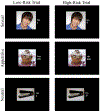Neural mechanisms of sexual decision-making in women with alcohol use disorder
- PMID: 33738536
- PMCID: PMC8238910
- DOI: 10.1007/s00213-021-05815-w
Neural mechanisms of sexual decision-making in women with alcohol use disorder
Abstract
Rationale: The co-occurrence of alcohol consumption and sexual activity is associated with increased risk for sexual assault, sexually transmitted disease, and unplanned pregnancy among young adult women with alcohol use disorder (AUD). There is considerable previous work demonstrating neural reactivity to alcohol cues in AUD. Because alcohol consumption and sexual behavior are both rewarding and tend to co-occur, sexual cues may produce similar neural reactivity in women with AUD, possibly indicating a shared mechanism underlying reactivity to both types of cues. Alternatively, reactivity to alcohol versus sexual cues may be distinct, suggesting domain-specific mechanisms.
Objectives: We investigated whether the decision vulnerabilities in AUD women regarding sexual activity were related to differences in brain activation compared to control women.
Methods: Women with (n = 15) and without (n = 16) AUD completed a hypothetical decision-making task during fMRI that presented low- or high-risk scenarios involving visual sexual, appetitive, and neutral cues.
Results: Results showed that sexual cues were more often endorsed by women with AUD compared to controls and elicited differential brain activation patterns in frontal, visual, and reward regions. During high-risk decisions, women with AUD failed to downregulate activation, causing hyperactivation compared to controls.
Conclusions: Visual sexual cues produced reactivity like that previously demonstrated for alcohol cues, suggesting a shared or domain-general mechanism for alcohol and sexual cue reactivity in women with AUD. Riskier sexual decisions in women with AUD may be a consequence of repeatedly pairing alcohol use and sexual activity, a characteristic behavior of this population.
Keywords: Alcohol use disorder; Alcohol use disorder reward networks; Co-sensitization; Cue reactivity; Decision-making; Female sexual risk; Incentive sensitization; fMRI.
Conflict of interest statement
Conflict of Interest
On behalf of all authors, the corresponding author states that there is no conflict of interest.
Data collection were sponsored by the National Institute on Alcohol Abuse and Alcoholism, National Institute of Health. We have no conflicts of interest to disclose.
Figures






Similar articles
-
Interaction between behavioral inhibition and neural alcohol cue-reactivity in ADHD and alcohol use disorder.Psychopharmacology (Berl). 2020 Jun;237(6):1691-1707. doi: 10.1007/s00213-020-05492-1. Epub 2020 Apr 13. Psychopharmacology (Berl). 2020. PMID: 32285159 Free PMC article.
-
Neural responses to stress and alcohol cues in individuals with pain with and without alcohol use disorder.Addict Biol. 2024 Dec;29(12):e70010. doi: 10.1111/adb.70010. Addict Biol. 2024. PMID: 39660770 Free PMC article.
-
Alcohol Cue Processing in Co-Occurring Bipolar Disorder and Alcohol Use Disorder.JAMA Psychiatry. 2023 Nov 1;80(11):1150-1159. doi: 10.1001/jamapsychiatry.2023.2726. JAMA Psychiatry. 2023. PMID: 37556131 Free PMC article.
-
The differential neural substrates for reward choice under gain-loss contexts and risk in alcohol use disorder: Evidence from a voxel-based meta-analysis.Drug Alcohol Depend. 2023 Jul 1;248:109912. doi: 10.1016/j.drugalcdep.2023.109912. Epub 2023 May 4. Drug Alcohol Depend. 2023. PMID: 37182355 Review.
-
Neurobiological correlates of cue-reactivity in alcohol-use disorders: A voxel-wise meta-analysis of fMRI studies.Neurosci Biobehav Rev. 2021 Sep;128:294-310. doi: 10.1016/j.neubiorev.2021.06.031. Epub 2021 Jun 23. Neurosci Biobehav Rev. 2021. PMID: 34171325 Review.
Cited by
-
Risky Decision-Making in Adults with Alcohol Use Disorder-A Systematic and Meta-Analytic Review.J Clin Med. 2023 Apr 18;12(8):2943. doi: 10.3390/jcm12082943. J Clin Med. 2023. PMID: 37109278 Free PMC article. Review.
References
-
- Abbey A (2011) Alcohol and dating risk factors for sexual assault: Double standards are still alive and well entrenched. Psychol Women Q 35(2):362–8
-
- Afonso VM, Sison M, Lovic V, Fleming AS (2007) Medial prefrontal cortex lesions in the female rat affect sexual and maternal behavior and their sequential organization. Behav Neurosci 121(3):515. - PubMed
-
- Akins CK, Bolin BL, Gill KE (2017) Cocaine preexposure enhances sexual conditioning and increases resistance to extinction in male Japanese quail. Learn Behav 45(3):313–22 - PubMed
-
- American Psychiatric Association (1994) Diagnostic and Statistical Manual of Mental Disorders (DSM-IV). Washington, DC
MeSH terms
Grants and funding
LinkOut - more resources
Full Text Sources
Other Literature Sources
Medical

